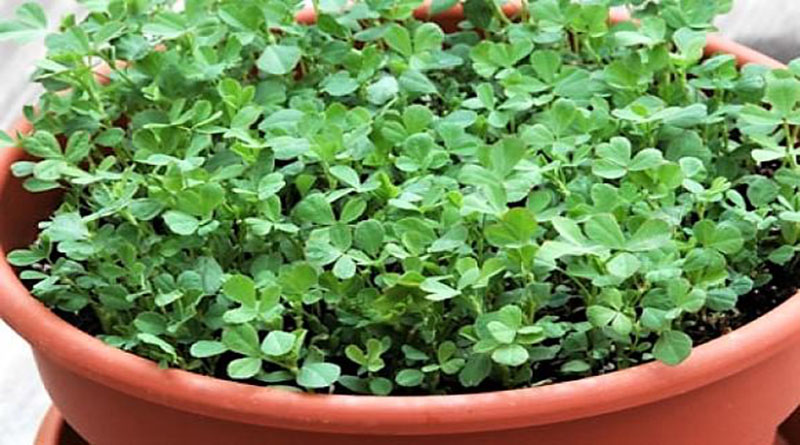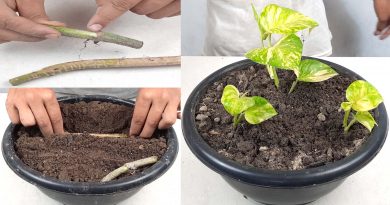How to Grow Fenugreek in your garden or containers in your balcony
‘Methi’ is native to Southwest Asia and widely cultivated for its medicinal and culinary uses. It’s an all purpose plant. Seeds are used as a spice, dried leaves as a herb, and fresh and tender leaves as a green leafy vegetable. It tastes little sweet with a touch of bitterness like mustard greens or bok choy. It can be a healthy alternative of spinach and any other greens.
Growing fenugreek is easy, whether you live in a warm climate or cool, both on grounds or in containers. You can also grow it indoors on windowsills in small pots. You can also plant it in your balcony vegetable garden or patio, terrace, and rooftop with lettuce, spinach, and other greens.
How to Grow Fenugreek
Create a fenugreek bed with cilantro or grow it alone. You can cultivate it from seeds. It’s easy even for beginners.
Sow seeds ¼ inches deep in a good potting mix or soil in the desired spot or container when all the dangers of frost are passed, and the weather starts to warm up (for cool climate).
Remember, fenugreek hates to be transplanted. Leave 2 inches of space for each plant while sowing seeds. They’ll sprout quickly, and you’ll see seedlings just within 2-5 days.
Note: Buy best quality seeds from the garden center or online. You can also buy it from grocery stores or spice shops as its seeds are sold as a spice but beware of poor germination rate.
You can directly sow seeds but if you’ve bought them from grocery stores, soak them overnight to increase germination rate before planting.
Growing Fenugreek in Containers
You can grow fenugreek in containers. It’s similar to any other green vegetable. Take a shallow but wide planter at least 6-8 inches deep with good drainage. Fenugreek has shallow roots so it won’t mind the low depth.
Fill the pot with rich potting mix. You can mix a 1/3 part compost or well-rotted cow or horse manure to it. Sprinkle seeds all over the pot and dust a thin quarter inch layer of soil briskly to cover them. Leave 1-2 inch of spacing between seeds. Don’t care about the spacing of seeds if you’re growing fenugreek as a microgreen.
Also Read: Best Microgreens You Should Grow
Growing Climate and Temperature
- Fenugreek grows well in a warm and hot climate when the temperature ranges from 50 to 90 F (10 C to 32 C).
- When planting it for seeds, grow it in spring or early summer. If you’re cultivating it to use as a vegetable or herb, then you can plant it anytime between spring to mid-fall.
- If you live in zone 9-11 or any warm place with frost-free winters outside the U.S., grow fenugreek year round.
Fenugreek Plant Care and Requirements
Location
Fenugreek prefers neutral to slightly alkaline soil with pH level around 6.5-8.2. Plant it in a spot that receives at least 4-5 hours of direct sun with shade in the afternoon. Prefer a sunny spot if you’re growing it in a climate where is not intense and the weather is cold.
Watering
Do regular watering to keep the soil slightly moist. Care not to over-water the fenugreek plant and avoid waterlogged soil. This will impede the growth and kill your plant.
If you’re growing fenugreek indoors or in a shady area, be vigilant about watering.
Fertilizer
Fenugreek does not require a lot of fertilizer. At the time of planting, you can mix manure or compost or time-based fertilizer in the soil, and that will keep it growing for a few weeks. Also, feed the plant with balanced liquid fertilizer, every other week for more robust growth.
Pests and Diseases
Fenugreek does not have many pests and diseases. Some pests and diseases that affect it are aphids, powdery mildew, charcoal rot, and root rot. You can easily save your plant from these problems by using organic pesticides regularly and watering properly.
Harvesting Fenugreek
In favorable conditions, within 20-30 days fenugreek will be ready for the first harvest. Trim the leaves gently to use as a leafy vegetable and prepare delicious recipes or air dry it to use as a herb. Leave the twigs, which will grow up again in 15 days. You can do this up to four times. To harvest fenugreek seeds, you will have to wait for 2-4 months, depending on the growing conditions.
Fenugreek Uses
It’s hot aroma like pepper and crunchy sour and sweet flavor gives it a distinctive taste, which you can’t compare with other vegetables. It is popularly used in Indian, Persian, Egyptian and Ethiopian cuisines, to prepare tastiest recipes. Fresh seeds are used to sprinkle on salad and dried seeds in pickles.
1,536 total views, 1 views today




